Class 11 - Mathematics
Conic Sections - Exercise 11-Misc
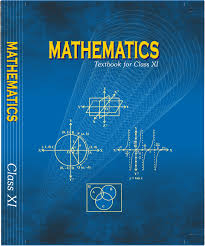
Top Block 1
Question 1:
If a parabolic reflector is 20 cm in diameter and 5 cm deep, find the focus.
Answer:
The origin of the coordinate plane is taken at the vertex of the parabolic reflector in such a
way that the axis of the reflector is along the positive x-axis.
This can be diagrammatically represented as
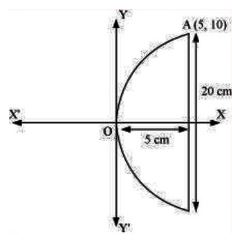
Since the parabola passes through point A(10, 5),
So, 102 = 4a * 5
⇒ 100 = 20a
⇒ a = 100/20
⇒ a = 5
Therefore, the focus of the parabola is (a, 0) = (5, 0), which is the mid-point of the diameter.
Hence, the focus of the reflector is at the mid-point of the diameter.
Question 2:
An arch is in the form of a parabola with its axis vertical. The arch is 10 m high and 5 m wide at the base.
How wide is it 2 m from the vertex of the parabola?
Answer:
The origin of the coordinate plane is taken at the vertex of the arch in such a way that its
vertical axis is along the positive y-axis.
This can be diagrammatically represented as
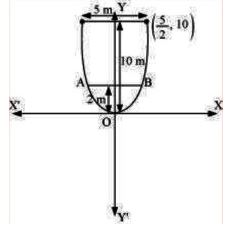
Mddle block 1
It can be clearly seen that the parabola passes through point (5/2, 10).
So, (5/2)2 = 4a * 10
⇒ 25/4 = 40a
⇒ 4 * 40a = 25
⇒ 160a = 25
⇒ a = 25/160
⇒ a = 5/32
Therefore, the arch is in the form of a parabola whose equation is
x2 = 4 * (5/32) * y
⇒ x2 = 5y/8
Now, when y = 2,
x2 = 4 * (5/32) * 2
⇒ x2 = 5/4
⇒ x = √(5/4)
Now, AB = 2 * √(5/4) = 2 * √5/2 = √5 = 2.23 (approx.)
Hence, when the arch is 2 m from the vertex of the parabola, its width is approximately
2.23 m.
Question 3:
The cable of a uniformly loaded suspension bridge hangs in the form of a parabola.
The road way which is horizontal and 100 m long is supported by vertical wires attached to the cable,
the longest wire being 30 m and the shortest being 6 m. Find the length of a supporting wire attached to the roadway 18 m from the middle.
Answer:
The vertex is at the lowest point of the cable. The origin of the coordinate plane is taken as the
vertex of the parabola, while its vertical axis is taken along the positive y-axis. This can be
diagrammatically represented as
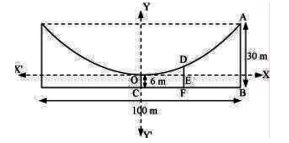
DF is the supporting wire attached to the roadway, 18 m from the middle.
Here, AB = 30 m, OC = 6 m, and BC = 100/2 = 50 m.
The equation of the parabola is of the form x2 = 4ay (as it is opening upwards).
The coordinates of point A are (50, 30 – 6) = (50, 24).
Since A (50, 24) is a point on the parabola,
So, 502 = 4a * 24
⇒ 2500 = 96a
⇒ a = 2500/96
⇒ a = 625/24
Now, equation of the parabola is
x2 = 4 * (625/24) * y
⇒ x2 = 625y/6
⇒ 6x2 = 625y
The x-coordinate of point D is 18.
Hence, at x = 18,
6 * 182 = 625y
⇒ 1944 = 625y
⇒ y = 1944/625 ⇒ y = 3.11 (approx.)
So, DE = 3.11 m
Now, DF = DE + EF = 3.11 m + 6 m = 9.11 m
Thus, the length of the supporting wire attached to the roadway 18 m from the middle is
approximately 9.11 m.
Question 4:
An arch is in the form of a semi-ellipse. It is 8 m wide and 2 m high at the centre. Find the height of the arch at a point 1.5 m from one end.
Answer:
Since the height and width of the arc from the centre is 2 m and 8 m respectively, it is clear
that the length of the major axis is 8 m, while the length of the semi-minor axis is 2 m.
The origin of the coordinate plane is taken as the centre of the ellipse, while the major axis is
taken along the x-axis. Hence, the semi-ellipse can be diagrammatically represented as
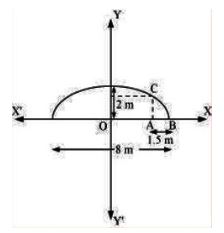
semi-major axis
Accordingly, 2a = 8
⇒ a = 4
and b = 2
Therefore, the equation of the semi-ellipse is x2/16 + y2/4 = 1, y ≥ 0 …………..1
Let A be a point on the major axis such that AB = 1.5 m.
Draw AC⊥ OB.
OA = (4 – 1.5) m = 2.5 m
The x-coordinate of point C is 2.5.
On substituting the value of x with 2.5 in equation 1, we obtain
(2.5)2/16 + y2/4 = 1
⇒ 6.25/16 + y2/4 = 1
⇒ y2/4 = 1 – 6.25/16
⇒ y2/4 = (16 – 6.25)/16
⇒ y2/4 = 9.75/16
⇒ y2 = (4 *9.75)/16
⇒ y2 = 9.75/4
⇒ y2 = 2.4375
⇒ y = √2.4375
⇒ y = 1.56 (approx.)
So, AC = 1.56 m
Thus, the height of the arch at a point 1.5 m from one end is approximately 1.56 m.
Question 5:
A rod of length 12 cm moves with its ends always touching the coordinate axes.
Determine the equation of the locus of a point P on the rod, which is 3 cm from the end in contact with the x-axis.
Answer:

Then, PB = AB – AP = (12 – 3) cm = 9 cm [AB = 12 cm]
From P, draw PQ⊥OY and PR ⊥ OX.
In ΔPBQ, cos θ = PQ/PB = x/9
In ΔPRA, sin θ = PR/PA = y/3
We know that,
sin2 θ + cos2 θ = 1
⇒ (y/3)2 + (x/9)2 = 1
⇒ x2/81 + y2/9 = 1
Thus, the equation of the locus of point P on the rod is x2/81 + y2/9 = 1.
Question 6:
Find the area of the triangle formed by the lines joining the vertex of the parabola x2 = 12y to the ends of its latus rectum.
Answer:
The given parabola is x2 = 12y.
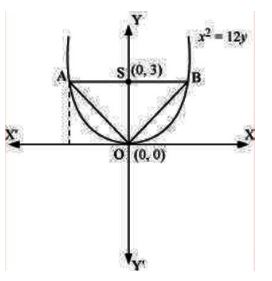
4a = 12
⇒ a = 3
So, the coordinates of foci are S(0, a) = S(0, 3)
Let AB be the latus rectum of the given parabola.
The given parabola can be roughly drawn as
At y = 3,
x2 = 12 * 3
⇒ x2 = 36
⇒ x = ±6
So, the coordinates of A is (–6, 3) and the coordinates of B is (6, 3).
Therefore, the vertices of ∆OAB are O(0, 0), A(–6, 3), and B(6, 3).
Area of ΔOAB = (1/2) * |0(3 – 3) + (-6)(3 – 0) + 6(0 – 3)|
= (1/2) * |-18 – 18|
= (1/2) * |-36|
= 36/2
= 18
Thus, the required area of the triangle is 18 unit2.
Question 7:
A man running a racecourse notes that the sum of the distances from the two flag posts form him is always 10 m and
the distance between the flag posts is 8 m. find the equation of the posts traced by the man.
Answer:
Let A and B be the positions of the two flag posts and P(x, y) be the position of the man.
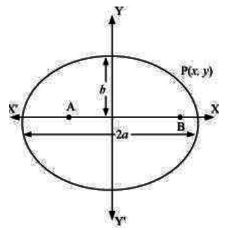
It is given that the sum of the distances of the man from the two flag posts is 10 m
This means that the sum of focal distances of a point on the ellipse is 10 m
⇒ PA + PB = 10
⇒ 2a = 10
⇒ a = 5
Again, given that the distance between the flag posts is 8 meters
⇒ 2ae = 8
⇒ ae = 4
Now, b2 = a2 (1 – e2)
⇒ b2 = a2 – a2e2
⇒ b2 = a2 – (ae)2
⇒ b2 = 52 – 42
⇒ b2 = 25 – 16
⇒ b2 = 9
⇒ b = 3
Hence, the equation of the path is x2/52 + y2/32 = 1
⇒ x2/25 + y2/9 = 1
Question 8:
An equilateral triangle is inscribed in the parabola y2 = 4 ax, where one vertex is at the vertex of the parabola.
Find the length of the side of the triangle.
Answer:
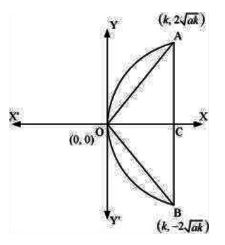
Let AB intersect the x-axis at point C.
Let OC = k
From the equation of the given parabola, we have
y2 = 4ak
⇒ y = ±2√(ak)
So, the respective coordinates of points A and B are(k, √(ak)) and (k, -√(ak))
Now, AB = CA + CB = 2√(ak) + 2√(ak) = 4√(ak)
Since OAB is an equilateral triangle,
OA2 = AB2
⇒ k2 + {2√(ak)}2 = {4√(ak)}2
⇒ k2 + 4ak = 16ak
⇒ k2 = 16ak – 4ak
⇒ k2 = 12ak
⇒ k = 12a
Now, AB = 4√(ak)
⇒ AB = 4√(a * 12a)
⇒ AB = 4 * a * 2√3
⇒ AB = 8a√3
Thus, the side of the equilateral triangle inscribed in parabola y2 = 4 ax is 8a√3 unit.
Bottom Block 3
Click here to visit Official CBSE website
Click here for NCERT solutions
Click here to visit Official Website of NCERT
Click here to download NCERT Textbooks

